Explore Guilin - China Travel, Asia
Nestled in the heart of Guangxi Zhuang Autonomous Region, Guilin stands as a testament to China's breathtaking natural beauty and rich cultural tapestry. Renowned for its dramatic karst landscapes, the city attracts travelers seeking a blend of stunning scenery and vibrant local traditions. Guilin's charm lies not just in its striking views but also in its warm hospitality and cultural heritage. Whether you’re cruising along the Li River or exploring the lively local markets, Guilin offers an authentic glimpse into both its historical and contemporary culture.
Population: Approximately 5 million in 2020.
Economy: One of the fastest growing economic regions of China and one of the most famous tourist destinations.
Landmarks: Famous for Li River, Reed Flute Cave, and Longji Rice Terraces.
China
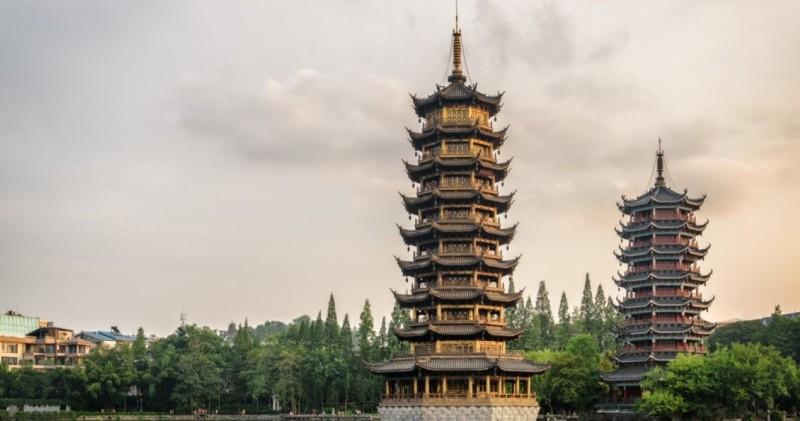
Overview of Guilin
History & Culture Influence
Guilin's history stretches back over two millennia, making it a significant cultural and historical hub in southern China. Established as a county during the Han Dynasty, the city has been a witness to numerous historical events and cultural transformations. Its history is deeply intertwined with the ancient Silk Road, which facilitated trade and cultural exchange. The city’s cultural influence is evident in its traditional architecture, ancient temples, and historic sites.These sites reflect the deep-rooted Confucian and local traditions that have shaped the city’s character.
Interaction with The Locals
Guilin, a vibrant city in southern China, has a population of approximately 5 million people. Its residents are a mix of various ethnic groups, including Han Chinese and Zhuang, which contribute to the city’s rich cultural tapestry. Guilin’s citizens are known for their hospitality and pride in their city’s natural beauty and historical heritage. This diverse community embraces both traditional customs and modern influences, creating a unique and welcoming atmosphere for visitors.
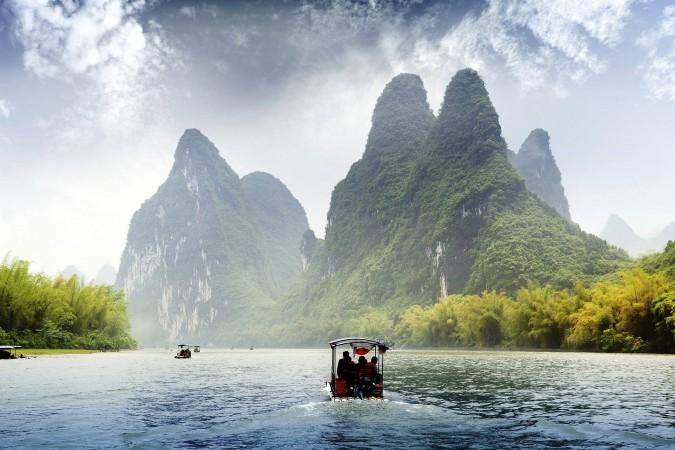
Cruising along Li River to witness Guilin's natural beauty - © Liufuyu
Top Attractions in Guilin
Guilin is a treasure trove of natural wonders and historical sites. Each of these attractions highlights different facets of Guilin’s charm, from its stunning natural landscapes to its rich historical heritage.
- Li River: Renowned for its breathtaking karst landscape, a cruise on the Li River offers stunning views of lush hills and dramatic rock formations. This scenic journey is a highlight of any visit to Guilin.
- Reed Flute Cave: This impressive limestone cave, also known as the "Palace of Natural Arts," features an array of striking stalactites and stalagmites, illuminated by colorful lights that enhance its otherworldly beauty.
- Elephant Trunk Hill: This iconic hill, resembling an elephant drinking from the river, is one of Guilin’s most famous landmarks. It’s a great spot for photography and provides panoramic views of the city.
- Longji Rice Terraces: Located a bit outside the city, these stunning terraces are a marvel of agricultural engineering. The intricate patterns of the terraces against the backdrop of the mountains make for breathtaking scenery..
- Yao Mountain (Yao Shan): The highest peak in Guilin, Yao Mountain offers panoramic views of the surrounding landscape. A cable car ride and hiking trails make it accessible for visitors seeking spectacular vistas.
- Fubo Hill: Known for its unique rock formations and cave temples, Fubo Hill provides excellent views of Guilin and the Li River. The hill’s name, which means “floating on water,” reflects its appearance when seen from afar.
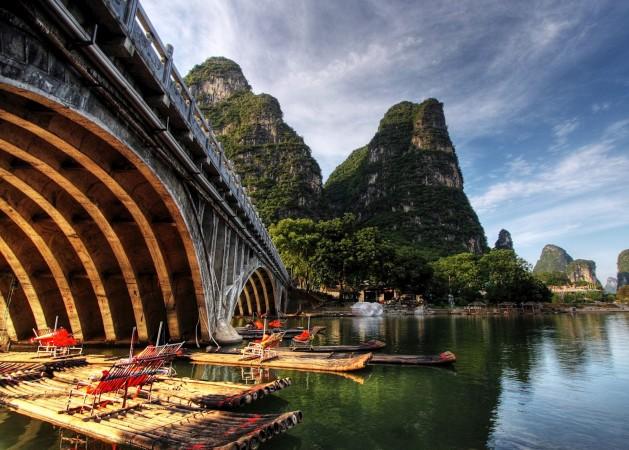
Li River's beauty - © South China Morning
Must-Try Dishes in Guilin
Guilin’s cuisine is as captivating as its scenery. The city’s local cuisine offers a delightful mix of flavors and textures that reflect its rich cultural heritage. Exploring these dishes provides a taste of Guilin’s culinary diversity and the opportunity to experience the city’s local flavors in an authentic way.
- Guilin Rice Noodles: This iconic dish is a staple of Guilin’s street food. Usually served with a variety of toppings like pickled vegetables, peanuts, and delicate pork or beef, the rice noodles are served in a flavorful broth. It's a comforting and flavorful experience.
- Lipu Fried Tofu: Known for its crispy exterior and soft, flavorful interior, Lipu fried tofu is a beloved snack. It’s often enjoyed with a tangy dipping sauce and is a great way to experience local flavors.
- Yangshuo Beer Fish: A regional specialty from nearby Yangshuo, this dish features fresh fish cooked in beer with a blend of aromatic herbs and spices. The result is a tender and flavorful fish that’s both savory and slightly tangy.
- Guilin Braised Pork: This dish highlights the local love for rich and savory flavors. Braised pork belly is cooked slowly with soy sauce, sugar, and spices, resulting in a melt-in-your-mouth texture and deep, sweet-savory flavor.
- Egg Fried Rice with Preserved Vegetables: A simple yet delicious dish, this fried rice incorporates preserved vegetables for an added crunch and flavor. It's a well-liked option for a filling and quick supper.
- Tea Eggs: Simmering hard-boiled eggs in a tea-based broth with spices results in a rich, savory taste and a marbling effect. They are a popular snack and a great way to experience local flavors.

Chinese Tea Eggs - © Slofoodgroup
Festivals & Local Celebrations
The lively local festivities and festivals in Guilin provide an insight into the customs and culture of the city. Participating in these festivals provides a unique opportunity to immerse yourself in Guilin’s cultural traditions and enjoy its vibrant community celebrations.
Guilin Lantern Festival
Held during the Lantern Festival, which takes place on the 15th day of the Chinese New Year (usually in February or March), this event is known for its colorful lantern displays and lively street performances. The festival features traditional dragon and lion dances, folk music, and various cultural performances, creating a vibrant atmosphere throughout the city.
Guilin International Tourist Food Festival
Typically celebrated in the spring, this festival showcases Guilin’s diverse culinary offerings. It features food stalls, cooking demonstrations, and tastings, allowing visitors to experience local specialties and international cuisine. The festival highlights Guilin’s gastronomic culture and attracts food lovers from around the world.
Longji Rice Terraces Festival
Held in the Longji Rice Terraces area, this festival occurs in late spring or early summer. It celebrates the harvest season with traditional dances, music, and ceremonies performed by the local Zhuang and Yao ethnic minorities. The festival provides insight into the agricultural traditions and cultural practices of these communities.
Guilin Tea Culture Festival
This festival, usually held in autumn, celebrates Guilin’s rich tea culture. Visitors can enjoy tea-tasting sessions, learn about tea-making processes, and participate in traditional tea ceremonies. The festival emphasizes the importance of tea in local culture and offers an opportunity to explore various types of Chinese tea.
Guilin Dragon Boat Festival
Celebrated in June, the Dragon Boat Festival features traditional dragon boat races on the Li River and other local waterways. The festival also includes activities such as making and eating zongzi (rice dumplings wrapped in bamboo leaves) and various cultural performances, reflecting the significance of this traditional holiday.
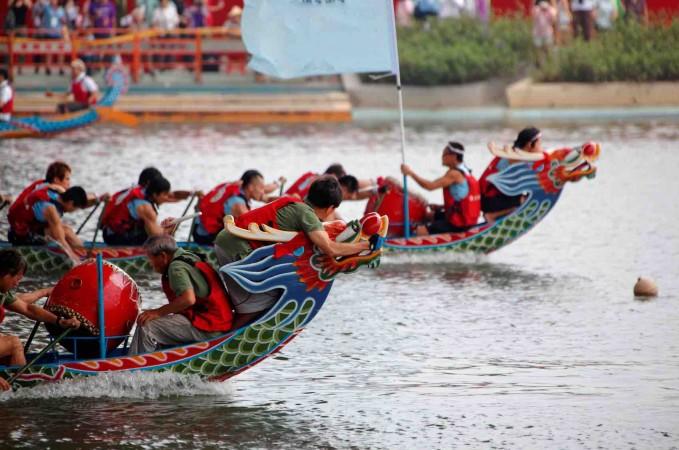
Guilin Dragon Boat Festival - © AaronChenPS2
What to Do in Guilin
Guilin offers a diverse range of activities that cater to both adventure seekers and those looking for relaxation. These activities offer a blend of adventure, relaxation, and cultural immersion, ensuring a memorable visit to Guilin.
- Li River Cruises: A cruise along the Li River is a must-do for its stunning scenery. Floating past dramatic karst peaks and picturesque rural landscapes, these cruises offer breathtaking views and a tranquil experience.
- Hiking and Outdoor Exploration: The surrounding countryside, including the Longji Rice Terraces and Yao Mountain, offers excellent hiking opportunities. Trails vary in difficulty, catering to both casual walkers and serious trekkers.
- Bamboo Rafting: Experience the natural beauty of Guilin from a bamboo raft on the Yulong River. This peaceful ride provides a unique perspective of the scenic landscape and an enjoyable way to connect with nature.
- Exploring Local Markets: Guilin’s markets are vibrant hubs of activity where you can shop for local handicrafts, try street food, and immerse yourself in the city’s everyday life.
- Cultural Tours: Discover Guilin’s rich history and culture through guided tours of historical sites such as the Jingjiang Princes' City and the ancient temples scattered throughout the city.
Shopping in Guilin
Guilin’s shopping options provide a variety of options for visitors seeking unique souvenirs and local products. Exploring these shopping experiences offers a glimpse into Guilin’s local culture and provides ample opportunities to find memorable keepsakes.
- Local Markets: The city’s bustling markets, such as the Guilin Night Market, are ideal for finding traditional handicrafts, local snacks, and souvenirs. These markets offer a lively atmosphere and a chance to interact with local vendors.
- Artisan Shops: Guilin is known for its traditional crafts, including embroidered textiles and bamboo products. Visiting artisan shops allows you to purchase high-quality, handcrafted items that reflect the city’s cultural heritage.
- Shopping Streets: Pedestrian streets like Zhengyang Road are lined with shops and boutiques selling everything from fashion to local delicacies. It’s a great place to browse and pick up gifts or personal items.
- Tea Shops: Guilin’s tea culture is well-regarded, and visiting a local tea shop can provide insights into traditional tea preparation. You can sample various teas and purchase high-quality leaves to take home.
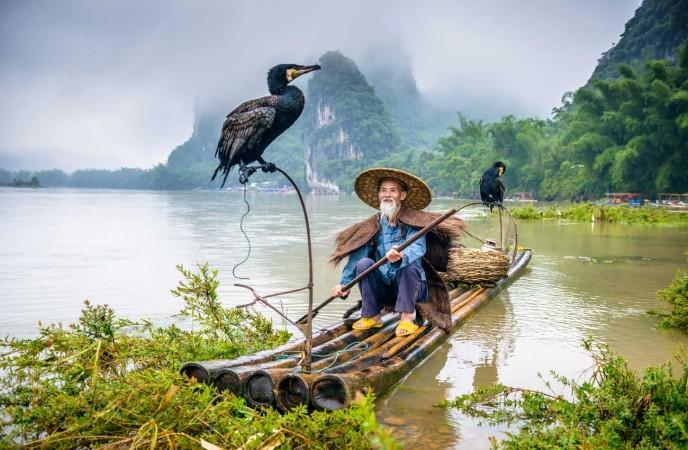
Bamboo Rafting in Guilin - © cleverreisen
Weather in Guilin: Best Time to Visit
Guilin's subtropical climate creates distinct seasonal experiences that can influence your travel plans. Knowing the weather trends will help you make the most of your visit planning:
Spring in Guilin
Spring in Guilin is marked by mild temperatures ranging from 15°C to 25°C (59°F to 77°F), making it an ideal time for outdoor activities. This season is perfect for exploring the lush landscapes of the Longji Rice Terraces and enjoying river cruises on the Li River. The pleasant weather also supports hiking and cycling, with blooming flowers adding a picturesque backdrop to your adventures.
Summer in Guilin
Summer brings warmer temperatures, often exceeding 30°C (86°F), and higher humidity. While the heat and frequent rains might deter some, this is the best time for river cruises and exploring the region's natural beauty. The vibrant greenery and flowing rivers are at their peak, making summer an excellent time for bamboo rafting and outdoor excursions. Be prepared for afternoon showers and consider light, breathable clothing to stay comfortable.
Autumn in Guilin
Autumn offers mild temperatures between 18°C and 28°C (64°F to 82°F) and drier weather, making it a popular time for tourists. The clear skies and comfortable temperatures are perfect for sightseeing and exploring Guilin's attractions, including the scenic views from Yao Mountain and the historical sites of Jingjiang Princes' City. The fall colors enhance the beauty of the landscape, providing great photo opportunities.
Winter in Guilin
Winter in Guilin is mild, with temperatures ranging from 8°C to 18°C (46°F to 64°F). The weather is still rather pleasant for taking river excursions and touring the city's sights even if it is becoming colder. This is a quieter time for tourism, offering a more peaceful experience at popular spots like the Reed Flute Cave and Elephant Trunk Hill. Winter’s cooler temperatures are ideal for those who prefer avoiding the crowds and enjoying a more relaxed pace.

Autumn in Guilin - © Wikimedia
Culture Etiquette in Guilin
Understanding local etiquette is key to enjoying a respectful and immersive experience in Guilin. Here are some important cultural norms:
- Respect Local Customs: When visiting temples or historical sites, dress modestly and avoid loud behavior. Removing your shoes before entering certain areas is also a common practice.
- Polite Greetings: A friendly handshake is a common greeting, though more traditional gestures like a slight bow can be appreciated, especially in formal settings.
- Dining Etiquette: At a dining table, it’s customary to wait for the host to start the meal. Use chopsticks properly and avoid sticking them upright in a bowl of rice, as this resembles a funeral ritual.
- Respect for Elders: Showing respect to elders is an important part of Chinese culture. Offering your seat to an older person or showing deference in conversations is appreciated.
- Tipping Culture: Tipping is not a common practice in Guilin, and it’s generally not expected in most service industries. However, small tips for exceptional service in restaurants or hotels are welcomed.
Essential Travel Information
Getting Around Guilin
Navigating Guilin is both convenient and versatile, with several transportation options to suit different preferences. The city boasts an extensive public bus network that efficiently covers most areas, providing an affordable way to travel, though buses can be crowded during peak times. Taxis are readily available and provide a cost-effective means of transport, while ride-sharing services offer a convenient alternative. For a more leisurely exploration, renting bicycles or e-scooters allows you to navigate the city at your own pace.

Rice Terraces in Guilin - © Man Chung
ATM & Banking Services
Managing finances in Guilin is simple with various banking and ATM options. ATMs are widely accessible throughout the city, including in shopping centers, banks, and airports, and most accept international cards for easy cash withdrawals. Many banks manage different financial operations and provide currency exchange services. Credit and debit cards are commonly accepted in hotels, restaurants, and larger stores, though it’s wise to carry some cash for smaller shops and local markets.
Where to Stay in Guilin
Guilin provides a wide range of accommodation options to cater to various preferences and budgets. For those seeking luxury, high-end hotels offer exceptional amenities, breathtaking views, and top-notch service. Mid-range hotels provide well-appointed rooms, handy locations, and comfort and value for money. Budget travelers can choose from affordable hostels and guesthouses that offer essential amenities at a lower cost. Boutique hotels offer a different and enchanting experience with their distinctive décor and individualized service.
Articles for you

Explore Yala National Park - Sri Lanka Travel, Asia
Tucked away in Sri Lanka’s southeastern corner, Yala National Park is where wild nature meets deep tradition. Known worldwide for its leopard population, the park is also home to elephants, sloth bears, crocodiles, and hundreds of bird species. Beyond wildlife, Yala opens doors to a cultural landscape dotted with ancient temples, Buddhist ruins, and coastal villages. For travelers seeking more than just a safari, Yala offers a chance to explore eco-tourism, local communities, and sacred heritage sites.
Population: The Yala National Park area doesn’t have a human population.
Economy: The economy around Yala National Park thrives on a blend of eco-tourism, agriculture, and local services. Safari tours, eco-lodges, and cultural experiences drive steady income for nearby towns like Tissamaharama and Kataragama, supporting thousands of families.
Landmarks: Famous for Block I of Yala and wildlife encounters, including elephants, sloth bears, crocodiles, and exotic bird species.

Explore Galle - Sri Lanka Travel, Asia
Nestled on Sri Lanka’s southern coastline, Galle is a vibrant city where history meets the sea. Its cobbled streets, colonial architecture, and serene beaches make it a must-visit destination for travelers seeking a blend of culture, adventure, and relaxation. A UNESCO World Heritage site, Galle captivates visitors with its Dutch Fort, bustling markets, and friendly locals. Whether you’re exploring the ramparts at sunset or savoring fresh seafood by the shore, Galle promises an unforgettable journey into Sri Lanka’s heritage.
Population: Approximately 113,000 in 2023.
Economy: Galle’s economy thrives on tourism, trade, and fisheries. The city’s historic fort, colonial architecture, and coastal charm draw thousands of international visitors each year, making tourism its main economic driver. Fishing remains vital for local livelihoods, supplying fresh seafood across the region.
Landmarks: Famous for the Galle Fort, Dutch Reformed Church & Maritime Museum, and Unawatuna Beach.

Explore Bentota - Sri Lanka Travel, Asia
Nestled along Sri Lanka’s southwestern coast, Bentota is a tropical paradise that blends golden beaches, vibrant culture, and thrilling adventures. Famous for its calm waters, luxury resorts, and scenic river estuary, Bentota has become a top destination for travelers seeking both relaxation and authentic experiences. From serene beach walks at sunrise to adrenaline-pumping water sports, this coastal town offers a perfect balance of leisure and exploration. With its proximity to Colombo and Galle, Bentota is easy to reach, making it an ideal stop for both short escapes and extended holidays.
Population: Approximately 37,000 in 2023.
Economy: Bentota’s economy thrives mainly on tourism, which drives local businesses such as hotels, restaurants, and wellness retreats. The town also benefits from fishing, coconut cultivation, and handicrafts like wood carving and batik textiles. Many residents rely on the growing demand for water sports and Ayurvedic treatments, making tourism the backbone of both income and employment in the area.
Landmarks: Famous for Bentota Beach, Bentota River Safari, and Kande Vihara Temple.

Explore Mirissa - Sri Lanka Travel, Asia
Mirissa is a charming coastal town on Sri Lanka’s southern shoreline. Known for its golden beaches, turquoise waters, and vibrant marine life, it has become a must-visit stop for travelers exploring the island. Many come for whale watching, surfing, and sunset views at Coconut Tree Hill, but Mirissa offers much more than postcard beauty. The fishing boats you see anchored by the bay carry generations of stories. Local traditions, delicious cuisine, and a laid-back rhythm of life shape every visitor’s experience.
Population: Approximately 4,700 in 2023.
Economy: Mirissa’s economy is largely shaped by its coastal location. Fishing has long been the backbone of local livelihoods, with generations relying on the Indian Ocean for income. In recent decades, tourism has become the main driver of growth, thanks to whale watching, surfing, and beachside hospitality.
Landmarks: Famous for Mirissa Beach, Coconut Tree Hill, and Parrot Rock Bridge.

Explore Nuwara Eliya - Sri Lanka Travel, Asia
Tucked away in the Central Highlands of Sri Lanka, Nuwara Eliya is often called “Little England”. With its rolling tea plantations, cool misty mornings, and colonial charm, this mountain town feels like a step into another world. Travelers come here to breathe fresh air, walk through flower gardens, sip the finest Ceylon Tea, and enjoy a pace of life far from the island’s busy cities. Whether you’re drawn by scenic landscapes, heritage architecture, or the warmth of its people, Nuwara Eliya is a destination that blends nature, culture, and history in perfect harmony.
Population: Approximately 781,000 in 2023.
Economy: Nuwara Eliya’s economy thrives mainly on tea production, as it sits in the heart of Sri Lanka’s central highlands, famous worldwide for Ceylon Tea. The city also benefits from a growing tourism industry, attracting visitors with its colonial charm, cool climate, and scenic landscapes.
Landmarks: Famous for Gregory Lake, Hakgala Botanical Garden, and Victoria Park.

Explore Sukau - Malaysia Travel, Asia
Nestled on the banks of the Kinabatangan River in Sabah, Malaysian Borneo, Sukau is a destination where wildlife, culture, and conservation come together. Known as one of Asia’s top spots for river safaris and eco-tourism, this quiet village offers a front-row seat to encounters with Bornean orangutans, pygmy elephants, proboscis monkeys, and exotic birdlife.
Population: Approximately 1,400 in 2019.
Economy: Sukau’s economy is shaped by its riverine location and natural resources. Traditionally, the Orang Sungai community relied on fishing, small-scale farming, and forest gathering for their livelihood. Today, the village has shifted toward eco-tourism, with river cruises, jungle trekking, and homestays providing income.
Landmarks: Famous for the Kinabatangan River cruises, Gomantong Caves, and Ox-bow lakes and wetlands.
